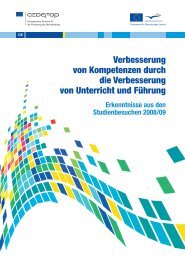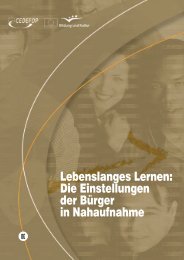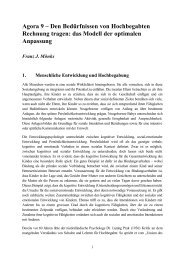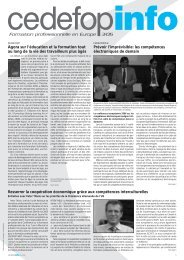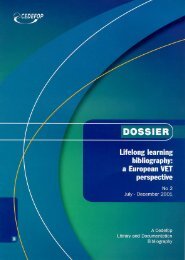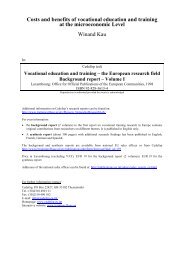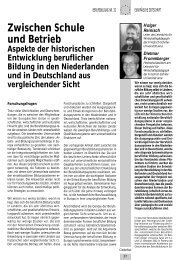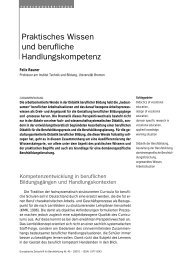Full text (pdf) - Cedefop - Europa
Full text (pdf) - Cedefop - Europa
Full text (pdf) - Cedefop - Europa
You also want an ePaper? Increase the reach of your titles
YUMPU automatically turns print PDFs into web optimized ePapers that Google loves.
Table 5: Positioning of the different calculation elements<br />
Primary orientation<br />
Subdivision<br />
Basis<br />
Secondary<br />
orientation<br />
Source: the authors<br />
Qualifications frameworks and credit systems: a toolkit for education in Europe<br />
Torsten Dunkel, Isabelle Le Mouillour<br />
ECVET ECTS<br />
Qualification Study programme<br />
Units<br />
Learning outcomes<br />
Training regulations,<br />
overall curriculum, etc.<br />
Courses of study<br />
Learning effort<br />
Qualification<br />
Learning outcomes<br />
Behind the different positioning of learning outcomes in the two procedures<br />
lies the fact that VET and higher education providers, or their competent authorities,<br />
are responsible for awarding and allocating credit points. Credits in<br />
ECTS can only be obtained after ‘successful completion of the work required<br />
and appropriate assessment of the learning outcomes achieved’ (European<br />
Commission, 2004, p. 1) and provide information about the related workload.<br />
They are therefore dependent on the achievement of a certain outcome, which<br />
implies that qualitative factors are to be taken into account. In relation to the<br />
– already largely completed – introduction of uniform academic degrees (bachelor/master),<br />
this means in principle that credits count throughout Europe as<br />
a standard for measuring academic learning effort or workload, and for the<br />
award of degree certificates (BA/MA). They likewise simplify the management<br />
of mobility. Credits therefore play a central role in ECTS.<br />
In ECVET, credit points are defined as ‘simple and broad indicators. They<br />
have no intrinsic meaning of their own’ (European Commission, 2006d, p. 14).<br />
However, a good deal still needs to be done if, by 2010, there really is to be<br />
an integrated European Higher Education Area with comparable academic<br />
structures and compatible diplomas as well as significantly improved mechanisms<br />
for academic validation. And for the time being there is no answer to<br />
the question of whether, and to what extent, it will be possible to allocate and<br />
transfer ECVET and ECTS credits reciprocally, or whether - as often postu-<br />
197




